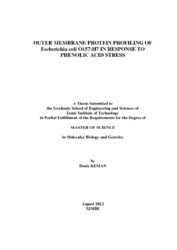Please use this identifier to cite or link to this item:
https://hdl.handle.net/11147/3477Full metadata record
| DC Field | Value | Language |
|---|---|---|
| dc.contributor.advisor | Soyer Dönmez, Ferda | en |
| dc.contributor.author | Keman, Deniz | - |
| dc.date.accessioned | 2014-07-22T13:51:37Z | - |
| dc.date.available | 2014-07-22T13:51:37Z | - |
| dc.date.issued | 2012 | en |
| dc.identifier.uri | http://hdl.handle.net/11147/3477 | - |
| dc.description | Thesis (Master)--Izmir Institute of Technology, Molecular Biology and Genetics, Izmir, 2012 | en |
| dc.description | Includes bibliographical references (leaves: 51-56) | en |
| dc.description | Text in English; Abstract: Turkish and English | en |
| dc.description | xi, 58 leaves | en |
| dc.description.abstract | Escherichia coli O157:H7 is a Gram-negative foodborne and waterborne pathogenic bacterium. Low doses of E. coli O157:H7 are adequate for infection that results in clinical cases, namely hemorrhagic colitis, thrombotic thrombocytopenic purpura, and hemolytic uremic syndrome. These diseases can be lethal for children, elderly and immunocompromised people. Phenolic acids are herbal secondary metabolites. They are important for the response to environmental stresses. They are significant for human diet due to their health beneficial properties. The objective of this study was the elucidate the antimicrobial mode of action of selected phenolic acids against E. coli O157:H7. The antimicrobial activities of caffeic, rosmarinic, and vanillic acids on E. coli O157:H7 were investigated via microtiter plate assay. Minimum inhibitory concentrations were found as 6.5 mM for caffeic acid, 15 mM for rosmarinic acid and 8 mM for vanillic acid by applying a range of concentrations for each phenolic acid against the bacteria. Effect of each phenolic acid on the cell surface of E. coli O157:H7 was visualized by scanning electron microscopy. Microscopic examination demonstrated that while the surfaces of control group E. coli O157:H7 remained intact, cells treated with phenolic acids displayed disrupted cell surfaces. The bacteria were treated with each phenolic acid at a concentration which resulted in 30-50% inhibition for evaluation of outer membrane protein (OMP) profiles in response to phenolic acids stress. Following OMP isolation, SDS-PAGE and 2D-PAGE analyses were performed. By examining the OMP profiles of phenolic acid treated-bacteria, differences in expression of some proteins were observed. | en |
| dc.language.iso | en | en_US |
| dc.publisher | Izmir Institute of Technology | en |
| dc.rights | info:eu-repo/semantics/openAccess | en_US |
| dc.subject.lcsh | Escherichia coli--Genetics | en |
| dc.subject.lcsh | Membrane proteins--Analysis | en |
| dc.subject.lcsh | Phenolic acids | en |
| dc.title | Outer membrane protein profiling of Escherichia coli O157:H7 in response to phenolic acid stress | en_US |
| dc.type | Master Thesis | en_US |
| dc.institutionauthor | Keman, Deniz | - |
| dc.department | Thesis (Master)--İzmir Institute of Technology, Molecular Biology and Genetics | en_US |
| dc.relation.publicationcategory | Tez | en_US |
| item.openairecristype | http://purl.org/coar/resource_type/c_18cf | - |
| item.cerifentitytype | Publications | - |
| item.fulltext | With Fulltext | - |
| item.languageiso639-1 | en | - |
| item.grantfulltext | open | - |
| item.openairetype | Master Thesis | - |
| crisitem.author.dept | 01. Izmir Institute of Technology | - |
| Appears in Collections: | Master Degree / Yüksek Lisans Tezleri | |
Files in This Item:
| File | Description | Size | Format | |
|---|---|---|---|---|
| T001014.pdf | MasterThesis | 1.06 MB | Adobe PDF |  View/Open |
CORE Recommender
Page view(s)
104
checked on Apr 15, 2024
Download(s)
46
checked on Apr 15, 2024
Google ScholarTM
Check
Items in GCRIS Repository are protected by copyright, with all rights reserved, unless otherwise indicated.